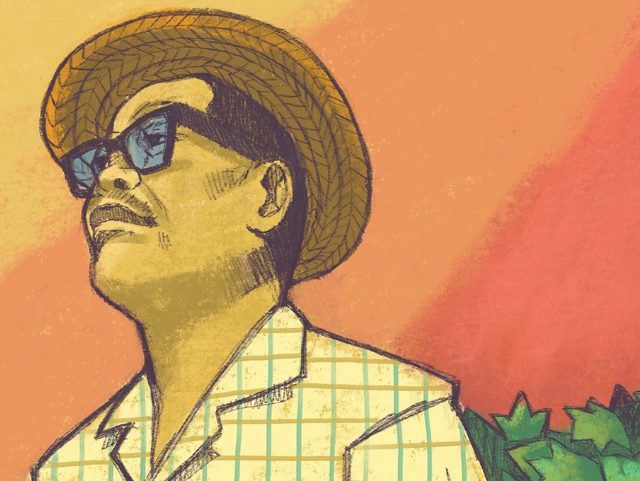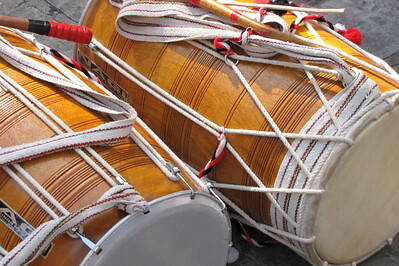When Stockton, California was the capital of Filipina/o America. An interview with Dawn Mabalon on the lost history of Filipinos in the organized labor movement, and the stories of women that went untold.

June 11, 2014
Silence had a sure and steady presence in my family household. My father, an immigrant from the Philippines who settled in Alaska in the 1940s to work in the salmon canneries, spoke nothing of his arrival to the U.S. or his work as a laborer in the California fields in the 1930s, a period that might as well have not existed. He was like other parents in the Filipino community, who sent their children to school for a coveted American education, instilling Philippine culture through food, dance, and celebration, but keeping their early struggles—the beginnings of their Filipino-American history—to themselves. Over the years bits and pieces of my father’s journey floated in like driftwood, sometimes questionable and often intriguing facts disconnected from a larger story.
Then, one spring, I discovered a photograph of someone at an exhibit on Filipino-American history at Stony Brook University in Long Island. That someone looked a lot like a younger version of my father. It was taken in Fresno, California in 1945 at a banquet to honor Philippine Commissioner Carlos Romulo, who was visiting the U.S. at the time to rally support for wartime efforts in the Philippines. The commissioner was the only person identified in the picture. I noted that the photograph came from the archives of the Filipino American National Historical Society (FANHS). A year later, in an effort to trace my father’s journey as a migrant laborer, I met with Dorothy Cordova, who welcomed me one summer afternoon at the FANHS headquarters in Seattle. She and her husband Fred are the founders of FANHS. Fred popped his head out of a smaller adjoining office to say hello and chatted briefly before returning to work on his novel. I was impressed by the sustained dedication and energy they put into their projects. Dorothy led me downstairs to the archives, a spacious room with endless shelves of uniform cardboard boxes, marked and organized alphabetically, containing file folders of individual and family histories, photographs, newspaper clippings, and more. Unfortunately, I did not find a file with my father’s information, and Dorothy could not tell me anything further about the people in the photograph I’d discovered at the exhibit, but she did invite me to come back the following day to meet her niece who happened to be in town for a book launch.
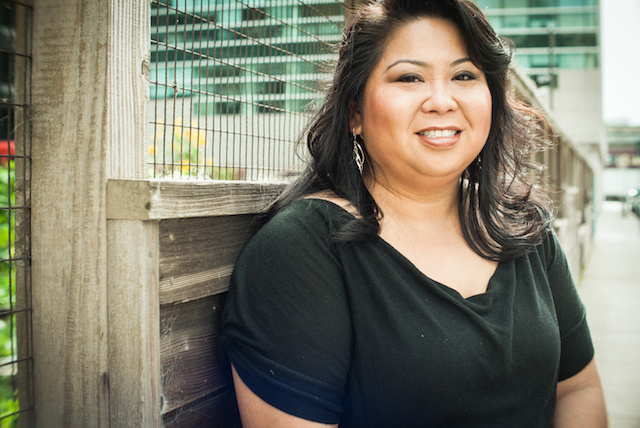
Her niece turned out to be Dr. Dawn Mabalon, Assistant Professor of History at San Francisco State University and author of Little Manila Is in the Heart: The Making of Filpina/o American Community in Stockton, California. Engaging and humorous, Dawn spoke about the book: the dreams, struggles, and the little known history of Filipinas/os in the United States, focusing specifically on the history of Filipinas/os in Stockton, California starting in the 1920s. It is an impressive, historical journey and a lens for understanding the larger story of Filipinas/os in the U.S. That day in the archives room, the audience resembled something closer to a family reunion: grandparents and grandchildren, friends, neighbors, and scholars, complete with sticky rice and ice cream. It was edifying and affirming to the core. Dawn’s presentation, like her book, broke open a silent history, details of which were unknown to me and many in my generation of Filipino Americans whose parents and grandparents were migrant laborers in the 1920s and beyond. As I looked around the room at a familiar scene that could have been plucked out of my own Filipino community in Alaska, I realized that history was in progress and Dawn’s book was both a bridge and a voice.
Nita Noveno: Your book party in Seattle was such an auspicious event for me—and meeting you, Dorothy, and Fred. I consider you all treasure keepers of Fil-Am history. Sadly, Fred passed away this winter. The work he did and that Dorothy continues is invaluable. You mentioned in your presentation that you’d travelled over the years to Seattle and spent a lot of time doing research in the archives. Can you tell me more about your research process?
Dawn Mabalon: I began going to Seattle in 1996 when I was writing my master’s thesis in Asian American Studies at UCLA; my thesis was about the Manangs, the women who arrived in Stockton before World War II. From the beginning, I was in awe of all that was in the archive and just so blessed to be embraced by Uncle Fred and Auntie Dorothy. There was so much to look at, so much to see, and I really learned how to do archival research at FANHS, how to look at documents, how to examine and interpret pictures and ephemera. Then, when that project was finished, I went to Stanford and started my dissertation, which would examine the whole community of Stockton for much of the 20th century. I went to the FANHS archives at least six times in the dozen or so years it took from the beginning of the dissertation to the book’s revisions in 2009. Each time I would find more: photographs, personal papers, oral histories, papers of organizations and labor unions, and newspapers. There was a point at which I had to stop looking or else the book would have turned into a multi-volume encyclopedia! The archives are so rich, so important. It begs for more scholars and students of history to dig into its riches.
America Is in the Heart by Carlos Bulosan is an inspiration for the book’s title. Can you explain Bulosan’s connection to this history and what led you to write this history?
I first learned about Bulosan sometime in high school. My dad was an avid reader of history and after his day was done in the fields, he would head straight to the library in his work clothes and would check out anything and everything on American and Philippine history: military history, agricultural history, American labor history, Philippine history during World War II. One day, he brought home America Is in the Heart by Bulosan and the progressive writer Carey McWilliams’ Brothers Under the Skin. I remember flipping through them and being intrigued, but I was an easily distracted high school student and yet to make the connection between those books and my own life and personal history. When I went to community college and took an Asian American History class in Stockton, I read Ronald Takaki’s book Strangers from a Different Shore and of course, Bulosan was mentioned. Then I transferred to UCLA and became a history major and started taking Asian American Studies courses. But it wasn’t until America Is in the Heart was assigned in my Filipino American Experience course taught by Royal Morales that it really transformed me. He talked about my hometown—and about Lafayette and El Dorado Streets—the intersection near my grandfather’s longtime Filipino restaurant that had been shuttered by 1983. Suddenly my family stories became history and I began to understand the context of my life as a third generation Pinay from Stockton. It took leaving home to understand and appreciate home.
When I went home to Stockton for a visit on a long weekend in 1993, I had an assignment for one of my Asian American Studies courses: to interview an elder. I chose my father’s best friend, Claro Candelario. He was always articulate and brilliant and a good storyteller. My father accompanied me. I mentioned that I was reading America Is in the Heart in class and he chuckled: “You know, I’m the Claro in the book!” And he proceeded to tell me about the real Carlos Bulosan who was a Communist and never worked in the fields, their long and close friendship that dated from Los Angeles in the 1930s, their left politics, and all the fun they had carousing, drinking, and gambling in the taxi dance halls. He showed me photographs of them together, and suddenly everything snapped into place. It was a stunning realization: that my family, my hometown, my history was History, with a capital H. I eventually decided to do my master’s in Asian American Studies and focused on women because as much as I loved America, I was critical of the absence of women in the narrative, especially since my grandmother and her friends were so powerful in Stockton. The MA program convinced me to go on to a Ph.D, and then I chose to write about Stockton. So much we learned about in Filipino and Asian American Studies courses centered around Stockton, but there was no scholarly book or article about Stockton in particular. And here I was, with the privilege of a full ride to Stanford, and I felt the blessing and the heavy responsibility to bring my community’s story to the larger public. I wanted a book that a young Pinay like myself could read in high school and college and understand the life of early Filipina/o Americans—men and women—and how they created our community. With militance, dignity, love, grace, and struggle.
My best friend, also a professor, Allyson Tintiangco-Cubales, suggested the title and it made sense. Bulosan wrote of people searching for community and a place to live, and then finding that they had made their own place—their own America was in their hearts, and they only had to realize that and to keep struggling for their place in the world and to make it a more just world. And that’s what I felt about Stockton’s Little Manila, that they came searching for a haven and made their own.
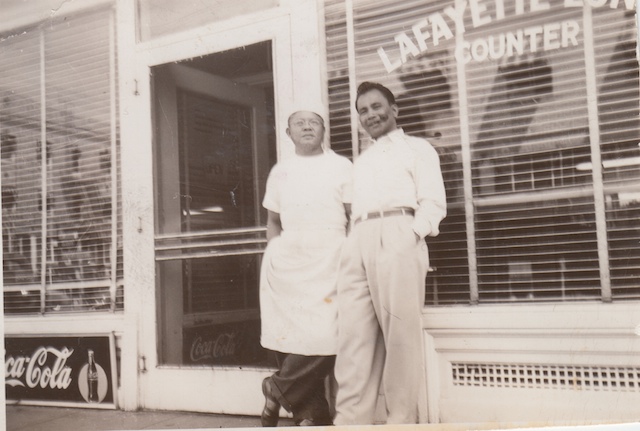
This history is so much about the forging of the Filipino-American identity in oppressive conditions and during a very restrictive, racist era in the U.S. Can you talk about some of these obstacles and challenges that Filipinas/os faced and how they dealt with these obstacles?
When I re-read the book and think about how much Filipinas/os could not do or strive for before World War II, it is heartbreaking. Imagine being in this country without hope to become a citizen, to vote, to organize labor unions, to live where you wish, to marry who you love, to work in anything but farm or domestic or service work, despite your education. It is not only amazing that these communities survived, but that they flourished. In the dark days of the Depression there was terrible pain but there was also the building of strong organizations, communities, families, and a network that they found. This is why Filipinas/os who were not blood related, but merely from the same region, or town, bonded like immediate family. I note in the book how burdens upon women were especially difficult—imagine all of this, plus you are taking care of children and the home and are also under threat of sexual violence within and outside of the community. In terms of labor, Filipinos organized unions and became militant in their demands for better working conditions. They didn’t win most of the time, but they made a statement about Filipinas/os being unwilling to be treated like animals in the fields.
For the most part, the population of Filipinos in the U.S. before the Second World War was in extraordinary contrast to Filipinas. You note, for example, in the 1930s the ratio of Filipino men to women in California was 14 to one and in New York it was 47 to one. So this history is very much about men. However, you bring in the women’s stories. There are individual stories like Angelina, a young Filipina, who rebelled against participating in beauty contests in her community, and the story of the Filipina pilots known as the “bomb droppers” who defy gender-role expectations. Why was it important to you to include these women’s stories and the history of Filipinas at the time?
My master’s thesis was my attempt to recover the stories of Filipina immigrant pioneers, who I felt were erased from the pre-WWII history, especially because of the heavy emphasis on Bulosan’s book as truth and as history (vs. as a piece of historical fiction, with a lot of it actually true, but missing so much in terms of community, organizations, and gender). And of course, I expanded even more on gender and women in the book. You can’t understand this period unless you understand how women’s and men’s roles were changing as a result of immigration, consumer and popular culture, and American colonial influence in the Philippines and public education. As a Pinayist historian, a feminist Pinay historian, I knew that gender was absolutely essential in understanding this history. Women emerge as particularly powerful because there are so few of them, yet they are also vulnerable to rape, harassment, and objectification. And I thought the stories of the ways young women tried to take control of their lives and images—the ones who took pilot and flying classes, the ones who created all-female organizations, the ones who refused to participate in beauty queen contests, the ones who eloped—really tell us so much about women’s power, desires, and about the fabric of the community. It’s not just bachelors—these women are right at the center.
What surfaces again and again in this history of Filipinas/os of the U.S. is the power of community and its strong leaders. In writing about the asparagus strikes of 1948-49, you highlight the unknown (I’ve seen this described elsewhere as “forgotten”) history of Larry Itliong, a dynamic Filipino-American labor leader who was instrumental, along with the more well-known Mexican-American labor leader Cesar Chavez, in gaining rights for farm laborers and setting the stage for immigrant labor activism and union building in the U.S. Itliong is also the subject of Marissa Aroy’s documentary about the “Delano Manongs.” Why are we only now learning about this history?
The story of Filipinos in the United Farm Workers (UFW) was buried for a number of reasons. Filipinos left the UFW in disgust in larger numbers by the early 1970s because they felt the UFW shafted them in the contracts, and they lost power and seniority in the union as it became dominated culturally and politically by Mexican Americans. Radical leftists like Itliong felt stifled by the anti-communism, staunch Catholicism, religious pageantry, and strict nonviolence as practiced by Chavez and those loyal to him in the union. Moreover, the Filipinos in the union represent a part of the UFW that those who focus on Chavez and the hunger strikes and the staunch Catholicism of the movement don’t understand. Many of the members of the Filipino union, the Agricultural Workers Organizing Committee, were veterans of the strikes of the 1920s, ‘30s, and ‘40s and were tough leftists, Marxists, and Communists. They shot scabs. They negotiated over shotguns. They met the violence of the growers with their own militance. They carried guns and knives for self-defense. They were feared within the labor movement, and the FBI had several of the Local 7 Filipino labor leaders under surveillance by the late 1940s for their Communist Party membership and/or leftist politics. So for them, the drama of marching behind statues, hunger strikes, turn-the-other-cheek style of UFW strikes were alien. Itliong also felt the union was becoming undemocratic and Chavez’s power was going unchecked. So he left in 1971 and historians of the UFW who focus on the long history of the union don’t accurately see his and the Filipinos’ important contributions—their militance, their decades of organizing experience.
Moreover, Chavez’s meeting with the dictator Ferdinand Marcos cost him the support of the Filipino left within and outside of the union, and Philip Vera Cruz, a founder and VP, left in disgust. Historians seeing the UFW as a Chicana/o movement don’t fully understand all of this complexity and the struggles over building a multi-ethnic union; they’ve taken the easy route of painting Chavez as a saint and the Filipinos as a dying minority within the union whose sole contribution was starting the strike. Then, in the 1980s and 1990s, as Filipina/o American Studies and Philip Vera Cruz himself began to recover the real history and tell it (Vera Cruz’s searing 1994 tell-all really tears into Chavez), Chavez was being propped up as a saint and everyone was naming streets and libraries and schools after him. It wasn’t time for a critical assessment in the media.
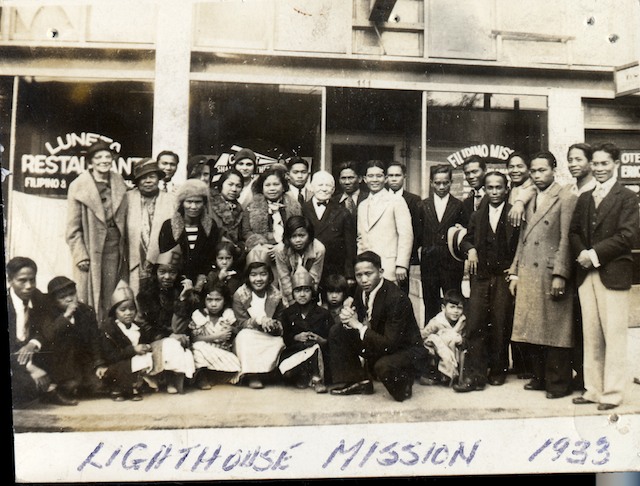
But now it’s time for a dramatic reassessment. With the Chavez movie doing such a poor job at getting at who he really was, the publication of books, even by Mexican-American historians (like Matt Garcia) who are critical of Chavez, and another by Miriam Pawel, and now the coming of age of folks like Marissa and I and a willing audience of Filipina/o Americans of all ages who are hungry for this history—I feel that this true history is finally seeing light. I’m so excited for Delano Manongs.
Next week I’m on my way to La Paz to the UFW headquarters, now the Cesar Chavez National Monument, to be a consultant for the new park. You wouldn’t have seen that 20 years ago. It’s a credit to our community that our political and cultural power has grown.
Today, the neighborhood of Little Manila in Stockton is a fraction of what it was in the 1920s and ‘30s. You write about the construction of the Crosstown Freeway, which led to the destruction of the neighborhood and mirrored the undoing of communities of color all around the country. You are now actively engaged in the preservation of Little Manila. Can you talk about this project further and its challenges?
I began the Little Manila Foundation in 1999 when I began going back home to do research and oral histories, and I discovered that one of the two remaining blocks of Little Manila—the one that held my grandfather’s restaurant—was slated to be demolished, all the Filipino old-timers kicked out, and a gas station and McDonalds put there. We rallied the community and created the Little Manila Historic Site, and have successfully fought all attempts to demolish the last three remaining historic Little Manila buildings. We’ve had significant victories—in 2003 Little Manila was listed as one of the 11 Most Endangered Historic Places in the U.S. by the National Trust for Historic Preservation when a Filipino developer wanted to tear it all down for a strip mall. We realized that we had to bring all of this history into greater context for the community—that these elders weren’t just their uncles and fathers, but they had national significance in our national history, and that we had to preserve this neighborhood because it was significant for all Filipinos and all Americans. Few people in Stockton get to take Filipino-American studies and experience that “WOW!” moment in which you realize the larger context of your family’s history. In order to do this we have educational symposiums and publish an annual “This Day in Filipino American History” calendar. We also published the Filipinos in Stockton book as a community project and I consider Little Manila Is in the Heart as part of this. Additionally, we created a Little Manila Afterschool Program to ensure that future generations learn this history that was only taught at UC Berkeley and SFSU and UCLA.
It’s been challenging because other Asian Americans don’t know this history and it has also been completely invisible in Stockton because of the long history of white supremacy and segregation in our city. For some new Filipino professional immigrants it’s a history of working class people they can’t connect with. It’s also challenging because Filipinos aren’t used to donating money to causes like ours, to preserve an old neighborhood. With our history in Stockton, we’re used to seeing everything eventually get torn down. We hope to partner with the Filipino American National Historical Society and bring the Filipino American National Museum to Stockton. That was Uncle Fred’s dream.
You mention near the end of the book the relationship between history and memory. What is the significance of this relationship for you?
It’s an important one. Filipinos in Stockton are on a journey towards realizing our memories and stories are history. We have been taught that it’s the growers and business owners and elite in Stockton who make history, and we only have our memories and those don’t mean as much. But realizing how we are a part of the American story is so empowering and so important. And that’s what I wanted to do with this book.

